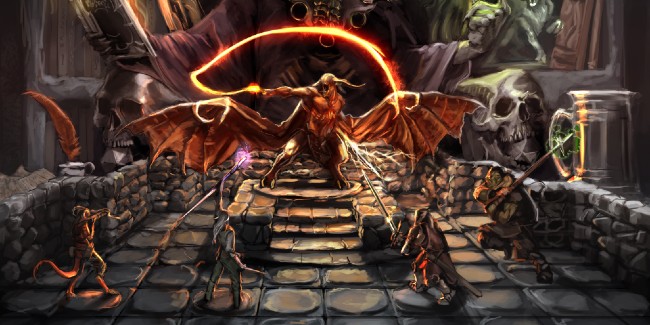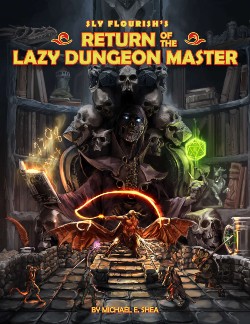As a dungeon master, I don’t run modules. I only run homebrew. I might pull bits and pieces from modules to insert into my homebrew game, but I would never run a pre-made module cover-to-cover.
Why? Quite frankly, because my players are assholes.
If there is one certainty in any game I run, it is that my players will never do the expected, never bite the hooks I cast, never pursue the course I set before them.
And why should they? The game isn’t about me or the world I created. It’s about them. They are the heroes. They are the arbiters of their own fates. I am merely a guide. A referee. A narrative voice for the world that surrounds them.
There was time (back in the late-80’s / early-90’s) when I would spend hours — weeks! — lovingly crafting every aspect of the imaginary world I prepared for my players. Hand-drawn maps that covered the entirety of my bedroom floor. Fully fleshed-out NPCs — with stats — for the PCs to interact with. Intricate storylines, plot hooks, and adventures awaiting them at every turn.
Sure, I was able to draw from that prepared content to force some story upon them. But how many hours were wasted on material that they never bothered to encounter? Or worse yet, encountered it and swiftly decided to ignore it, bypass it, or just kill-it-all-burn-it-to-the-ground-and-take-the-loot.
The answer is “most.” Most of that time creating imaginary masterpieces was wasted, at least in terms of running the game for my players (personal satisfaction not withstanding, who has time for that and a full-time job?).
So what’s the important lesson to learn here?
Don’t waste massive amounts of time preparing a game for your players.
You can’t prepare nothing. But you CAN focus on preparing just those few things which most benefit your game and your players. And this is where Return of the Lazy Dungeon Master comes to the rescue.
Who Is the Target Audience?
This book could be useful for any dungeon master, especially those with a little bit to a lot of experience. But even first-time DMs can extract value — better to learn good technique from the start.
Return of the Lazy Dungeon Master was written by Michael E. Shea (Sly Flourish) with Dungeons & Dragons Fifth Edition in mind, but the same principles could apply to any TTRPG. This method works very well for preparing and running both homebrew games and for published adventures.
What’s the Purpose?
This book helps you get more out of your RPGs by preparing less. Much of it centers on improvisation and focusing on the few key areas that will give you the most bang-for-your-buck when it comes to game preparation. In other words, it’s the Pareto principle applied to dungeon mastering.
I’m trying to save time and be lazy, so why am I reading a 100-page book?
Very Skimmable
You can assimilate a lot of the information quickly even if you don’t read every single word and mull over each example.
Pick and Choose
You can look through the table of contents and focus on the chapters you find new, interesting, or worthy of further study and skip the areas you feel strong in.
Do It Piecemeal If You’d Like
Improve on one aspect of your gaming style per week if you don’t want to read it all at once.
It’s Really Not That Long of a Read
You can more than make up for the time spent reading it with the time saved in future game prep after you implement these practices. I personally found it useful to read all the way through. Even chapters that seemed to cover topics I already knew well surfaced useful suggestions, methods, and insights that became valuable additions to my DM repertoire.
Content Overview for Return of the Lazy Dungeon Master
The primary content of the book is split between two broad topics: minimalist game preparation and improvisation.

Game Preparation, Lazy DM Style
The overarching concept begins with a checklist of eight steps to review prior to each game session:
- Review the characters
- Create a strong start
- Outline potential scenes
- Define secrets and clues
- Develop fantastic locations
- Outline important NPCs
- Choose relevant monsters (especially “boss fights”)
- Select magic item rewards
This framework is malleable. Each game session you prepare will incorporate these steps differently, emphasizing some more than others and potentially skipping some steps if they are not required for that particular session. The checklist paints broad strokes, giving form and potential direction to your campaign. Improvisation — including player choices — colors in the finer details as whim and circumstance dictate.
The book devotes a full chapter to each step. It breaks down the why, what, and how. It provides explanations, examples, and resources to make each step a useful tool.
Prepare what benefits your game, and omit what does not
Sly Flourish
If you’re really lazy, Sly Flourish includes a chapter on reducing your preparation even more. Eight steps too much for you? No problem, he prioritizes the top three! He also gives advice on how to combine steps and reduce workload by increasing your improvisation skills.
Other game prep chapters cover DM tools to make running the game easier, reskinning, building a campaign arc the lazy way, and running a session zero.
Be Prepared to Be Unprepared
As previously stated, minimal preparation just provides the broad strokes. Applying the finer details needed to complete this work of art requires a solid understanding of improvisation.
The second half of Return of the Lazy Dungeon Master focuses on running your game and maintaining a DM mindset.
Chapters cover the following topics:
- Traits of a good DM
- Summarizing previous sessions
- Group storytelling
- Improvising NPCs
- Improvising scenes
- Combat styles
- Pacing
- Mental models and exercises
- What players really want
- Lazy DM tricks
- DM survey results
These chapters help train your brain to know what to prepare, how to get your players involved and interested, and how to adapt your game on the fly.
Lazy Dungeon Mastering in Practice: Real-Life Example
The principles of Return of the Lazy Dungeon Master are great in theory, but the proof is in the pudding. So after reading the book (which I backed on Kickstarter), I immediately decided to test its efficacy. Remember those asshole players I referenced in the intro? Yeah, them.
Session Zero and Campaign Creation
Most DMs go into Session Zero with their campaign concepts already established. They share these ideas, get player buy-in, and players make campaign-appropriate characters.
In order to fully embrace my lazy DM potential, I decided to start my campaign with a Session Subzero. I had no plan, no campaign concept, no expectations. I just had one question, directed at my players: “What makes a roleplaying game enjoyable for you?”
My players don’t need a lot of fancy terrain, miniatures, professional-grade handouts, etc. They demand engaging and intriguing stories and settings in which they can have complete autonomy on how to interact and make their mark on the world.
They wanted intricate storylines woven into a world in motion style of game where they had freedom to interact (or not) with external events. They wanted their choices to have consequences, for their decisions and actions to affect the world. They wanted to rise in power from obscurity to rulership. They also wanted unique magical abilities, their powers separating them from the normies.
Keeping in line with the lazy DM mentality, I decided on the spot to start things as small and easy as possible while still fulfilling their game expectations. The PCs would come from a tribal culture (same tribe) and no spellcasting classes were permitted (unless they wanted to be a spellcasting class with no spells — which one of them did!).
Using a table from Return of the Lazy Dungeon Master, the players established relationships so they all had reasons to adventure together. With parameters established, they set out to make level 1 characters. I set out to create a campaign with a goal to be ready to run it by the time they were done with character creation.
Once again I channeled the lazy DM. Uber-lazy. I gave myself one 3×5 notecard and just three of the eight game prep steps (just enough to get us through the first session): outline important NPCs, define secrets, and create a strong start.
I jotted down 5 NPCs, which were just names and basic personalities: a father-figure, three elders (tribal council), and a villain (a member of the tribe who was up to no good). I wrote down 5 potential secrets that the PCs might discover (the book suggests making 10, but that’s how lazily I roll!). I decided on a strong start — a kobold attack on their village to get them straight into the action.
That’s it. My entire game prep took 10 minutes. I waited patiently for them to finish character creation so we could start the game.
Outcomes
The result of all this was a year-long world-spanning campaign that progressed from local tribal issues to regional warfare to conquering a continent to challenging the gods to achieving godhood.
Not bad for a brief conversation with my players and 10 minutes of game preparation.
How to Consistently Be a Lazy Dungeon Master
So my first lazy DM session went smoothly, but how did these principles serve me over the course of a year-long campaign? Clearly, the world became much more complex: opposing factions, wars, political intrigue, the meddling of gods, etc. That doesn’t sound very lazy.
But I stuck to the framework. Actual pen-to-paper game prep time never exceeded 15 minutes. However, I thought about the campaign quite frequently outside of my preparation phase. This wasn’t a burden, as thinking can coincide with plenty of other activities: exercising, doing chores, pretending to listen to my wife, etc. I think a goal of 30 minutes preparation per 3-4 hour session is achievable for most dungeon masters.
Admittedly, keeping to this limit in a complex campaign requires some experience and organization. Focus on what matters, omit the rest. Prepare the most important things, improvise the rest.
Minimal Preparation + Plentiful Improvisation = Maximal Satisfaction
Here are a few activities I did — and suggest you consider — to minimize game prep time:
- Focus on the characters and their goals
- Let the players contribute to creating the setting — less work for you and players get more invested in the game
- Review the 8 steps as part of game prep — expand/contract as needed
- Quickly review your preparations just before the game starts
- Keep notes while gaming (or summarize each session afterward) and review those notes when prepping the next session
- Use NPC and monster templates liberally — there is no reason to ever build out a fully-classed NPC
- Reskinning is your friend — the physical appearance of one monster with the stats and abilities of another is a completely new creature as far as PCs are concerned
- You can also reskin fantasy maps — just use part of a dungeon to make it smaller, or rename cities and countries to lay over a continent map
- Browse concept art galleries to inspire your fantastic locations
- There are tons of free and cheap resources available online to supplement maps, NPCs, puzzles, handouts, plot hooks, adventures, etc. — creators have put a lot of time into making these resources so you can save that time by using their creations
- The Lazy DM’s Workbook (read my review here) — a companion to Return of the Lazy DM — is an excellent resource for streamlining improvisation
Conclusion
Sly Flourish’s Return of the Lazy Dungeon Master teaches the specifics of an efficient less-is-more approach to running tabletop RPGs. The eight steps provide detailed methods for drastically reducing your game preparation time by focusing on only the most important factors. And later chapters help the DM improve improvisation skills and mental models to fill the gaps. It is a valuable resource to DMs of any experience level.
Return of the the Lazy Dungeon Master is available in both PDF and print editions. Click here to get it now.

